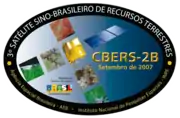| Mission type | Remote sensing |
|---|---|
| Operator | CNSA / INPE[1] |
| COSPAR ID | 2007-042A |
| SATCAT no. | 32062 |
| Mission duration | 2 years (planned)[2] |
| Spacecraft properties | |
| Spacecraft type | CBERS |
| Bus | Phoenix-Eye 1[1] |
| Manufacturer | CAST |
| Launch mass | 1450 kg |
| Dimensions | 1.8 x 2.0 x 2.2 m |
| Power | 1100 watts |
| Start of mission | |
| Launch date | 19 September 2007, 03:26:13 UTC[3] |
| Rocket | Long March 4B |
| Launch site | Taiyuan Satellite Launch Center, LC-7 |
| Contractor | SAST |
| End of mission | |
| Last contact | 10 May 2010 |
| Orbital parameters | |
| Reference system | Geocentric orbit[4] |
| Regime | Sun-synchronous orbit |
| Perigee altitude | 773 km |
| Apogee altitude | 774 km |
| Inclination | 98.60° |
| Period | 100.30 minutes |
| Epoch | 19 September 2007 |

| |
China–Brazil Earth Resources Satellite 2B (CBERS-2B), also known as Ziyuan 1-2B, was a remote sensing satellite operated as part of the China–Brazil Earth Resources Satellite program between the Chinese Center for Resources Satellite Data and Application and Brazilian National Institute for Space Research.[1] The third CBERS satellite to fly, it was launched by China in 2007 to replace CBERS-2.[3]
Spacecraft
CBERS-2B was a 1,450-kilogram (3,200-pound) spacecraft built by the China Academy of Space Technology and based on the Phoenix-Eye 1 satellite bus.[1] The spacecraft was powered by a single solar array, which provided 1100 watts of electricity for the satellite's systems.[2][5] The 1.8 m x 2.0 m x 2.2 m, triaxially-stabilized spacecraft carries a low 20 m resolution, and a higher 2.5 m resolution camera. The data help in crop estimation, urban planning, water resource management, and military intelligence.[6]
The instrument suite aboard the CBERS-2B spacecraft consisted of three systems:
- Wide Field Imager (WFI) produced visible-light to near-infrared images with a resolution of 260 meters (850 feet) and a swath width of 890 kilometers (550 miles).
- High-resolution CCD camera was used for multispectral imaging at a resolution of 20 m (66 ft) with a swath width of 113 km (70 mi).
- High Resolution Camera (HRC) was a panchromatic imager with a resolution of 2.5 m (8 ft 2 in) and a swath width of 27 km (17 mi).[7]
The HRC replaced the lower-resolution Infrared Multispectral Scanner instrument flown on earlier CBERS satellites.[1]
Launch
A Long March 4B carrier rocket, operated by the China Academy of Launch Vehicle Technology (CALT), was used to launch CBERS-2B. The launch took place at 03:26:13 UTC on 19 September 2007, using Launch Complex 7 at the Taiyuan Satellite Launch Center (TLSC).[3] The satellite was successfully placed into a Sun-synchronous orbit.[8]
Last contact
The CBERS-2B spacecraft suffered a power system failure on 10 May 2010, leaving it unable to continue operations. It remains in orbit.[4]
References
- 1 2 3 4 5 Krebs, Gunter. "CBERS 1, 2, 2B / ZY 1A, 1B, 1B2". Gunter's Space Page. Retrieved 1 December 2013.
- 1 2 "CBERS-1 (China-Brazil Earth Resources Satellite) - 1st Generation Satellite Series". Earth Observation Portal. European Space Agency. Retrieved 1 December 2013.
- 1 2 3 McDowell, Jonathan. "Launch Log". Jonathan's Space Page. Retrieved 1 December 2013.
- 1 2 "CBERS 2B Satellite details 2007-042A NORAD 32062". N2YO. 25 January 2015. Retrieved 25 January 2015.
- ↑ "CBERS-1, 2 and 2B Description". INPE. Archived from the original on 20 January 2014. Retrieved 1 December 2013.
- ↑ "Display: CBERS 2B 2007-042A". NASA. 14 May 2020. Retrieved 26 July 2020.
 This article incorporates text from this source, which is in the public domain.
This article incorporates text from this source, which is in the public domain. - ↑ "CBERS-1, 2 and 2B Cameras". INPE. Archived from the original on 20 January 2014. Retrieved 1 December 2013.
- ↑ "UCS Satellite Database". Union of Concerned Scientists. Archived from the original on 9 September 2010. Retrieved 1 December 2013.